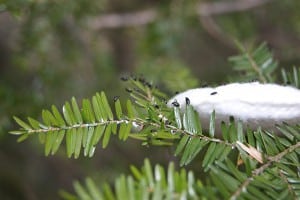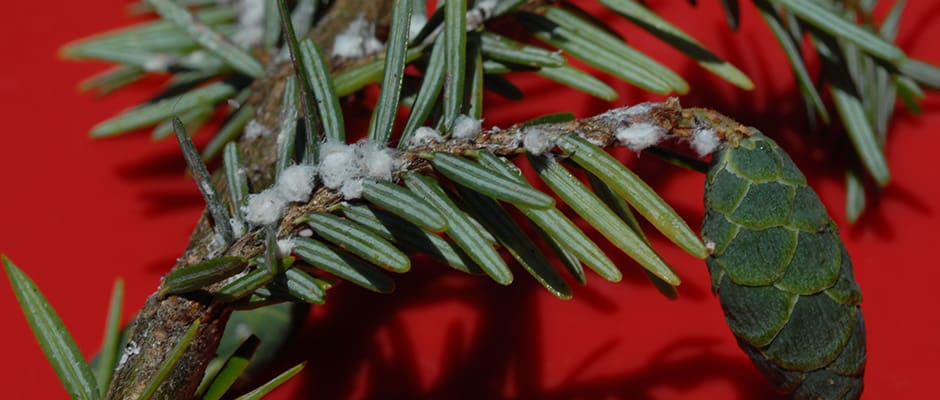Share this article
Predator Beetles Fight to Save Hemlocks
The responsibility for saving hemlock forests in the eastern United States could rest, at least partly, on the shoulders of tiny “vampire” beetles and the efforts of “ninja beetle collectors.”
“Hemlocks can be saved, and all we need to do is continue to get more organized and make a really big push to create more beetles,” said Richard McDonald, an entomologist and the owner of Symbiont Biological Pest Management — a private pest control company.

Lari beetle adults being released on a branch. Each adult beetle eats between six to eight woolly hemlock adelgid adults per day.
Image Credit: Richard McDonald.
McDonald is working with the North Carolina Wildlife Resources Commission on the Hemlock Restoration Initiative to try to slow down the spread of invasive hemlock woolly adelgids (Adelges tsugae) killing eastern hemlock (Tsuga canadensis) and Carolina hemlock (Tsuga caroliniana) trees that make up an intrinsic part of ecosystems in more than 19 eastern states including Ohio, Pennsylvania and others.
“They’re a keystone ecological species that has no analogue,” McDonald said.
The adelgids, a tiny, aphid-like species originally native to Asia, kill the trees over the course of a few years by eating the newly growing tips. They lay eggs in sacks on the tree “like jiffy pop popcorn — it just gets bigger and bigger,” McDonald said. But unlike many species, the first generation of the insects is active during the winter — a time when there are few natural predators around to keep populations in check in the East.
While ecosystem managers have employed chemical treatments and other techniques to control the pests, these were sometimes difficult to apply in more remote forest areas such as the hemlock ecosystems in the Appalachian Mountains.
But hemlocks along the Pacific Rim of the U.S. Northwest have natural allies in Lari beetles (Laricobius nigrinus) — a “sesame-seed size” beetle that feeds exclusively on the adelgids and is active during the winter when their attention is needed the most.
“These things eat six to eight adelgids a day — they’re vampires,” McDonald said. “It’s what holds the adelgid in check in the Pacific Northwest.”
Fighting Invasive Fire with Invasive Fire
Fighting an invasive species problem by introducing another species not native to an area can be contentious and have unforeseen effects. But McDonald and others spend years testing the beetles to make sure they would exclusively prey on the adelgids in order to satisfy state concerns with the plan.
Once approved, McDonald said he went to the Northwest where he became “Johnny Lariseed,” gathering beetles and transporting them to test areas in the east.
“We need to become ninja beetle collectors. And that’s what some of us did.”
And McDonald said the appetite of the beetles for adelgids gives hemlocks a fighting chance. “Once you have less than 30 percent of the needles of a hemlock infested with adelgids, the hemlock will be fine,” he said. But after the beetles were released on hemlocks, “the trees started regrowing.”
It’s been so successful that McDonald has released beetles in around 50 spots just in North Carolina over a 12-year period since the plan was approved in 2003, including most recently a release in the Sandy Mush Game Land. He’s also been giving beetles to forest managers in around 19 other states.
Robert Jetton believes the Lari beetles are a “necessary step” due to the “catastrophic loss” the adelgids are causing.
Jetton is a research assistant professor in the Department of Forestry and Environmental Resources at the North Carolina State University. Jetton also works with Camcore, an organization that focuses on banking hemlock seeds, among other things, so that trees can be replanted once effective measures to control the adelgid problem have been instituted.
He said that the beetles could provide an effective long-term strategy for dealing with the adelgids. “In the old days they used to just go find something, bring them back and release them,” he said, noting that McDonald and others did years of research on the beetle before releasing it.
Jetton said that the beetles aren’t the only strategy being employed to fight the adelgids. Aside from the banking of seeds for future replanting and creating hemlock orchards that his organization is doing, he said that in some cases chemical control is also effective.
“It’s a difficult situation when we have an invasive like this that comes in and is so damaging to the forest,” Jetton said. “We really have to explore every option and come up with as many different tools as possible for combating it.
Partly to compliment the appetites of the Lari beetles, McDonald said they are also now using another predator from the western U.S., the Scymnus coniferarum. These insects attack the adelgids during the summer stages of the pests’ lives when the Lari beetles aren’t as active. “The summer predator is probably critical as well because it exists in drier windy areas,” McDonald said. “It gets the second inning chance, or the tag team.”
These efforts are important on a larger level because they will help restore game land and wildlife habitat. “From a wildlife standpoint, hemlocks are ridiculously important,” McDonald said.
“It makes me sick to see what happened and how many trees died but now we know enough to heal it.”
Header Image:
An eastern hemlock branch and needles infested with tiny woolly hemlock adelgids. These invasive insects have wreaked havoc on hemlock forests in the eastern U.S.
Image Credit: Michael Montgomery, USDA.








